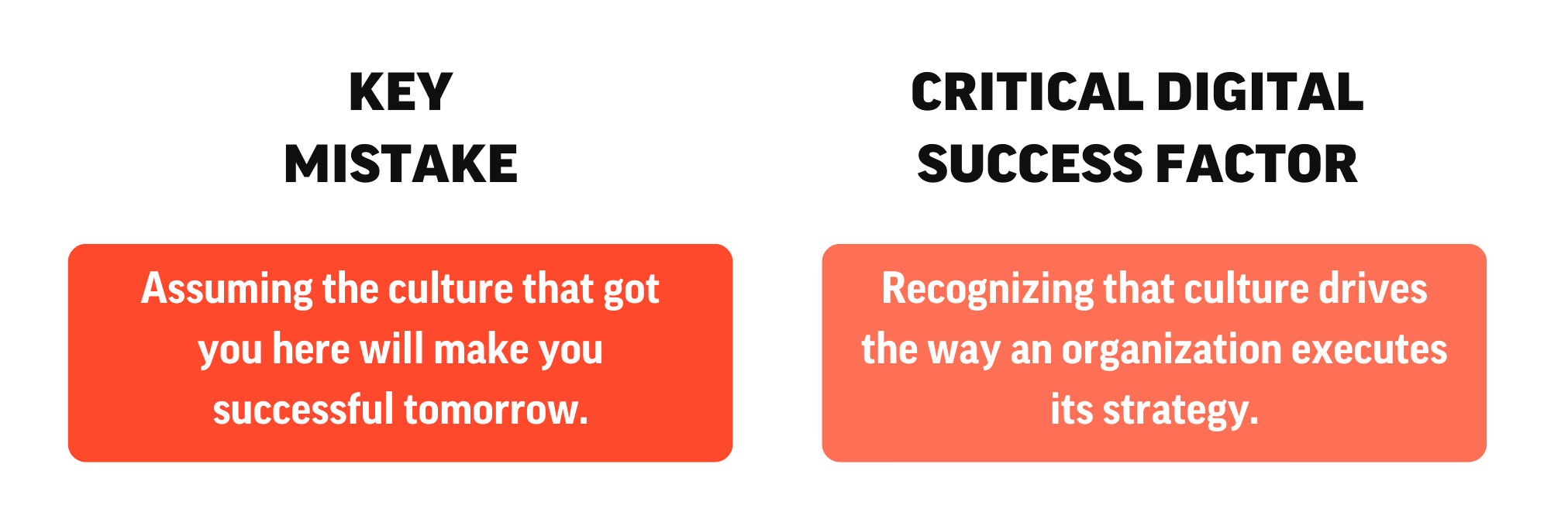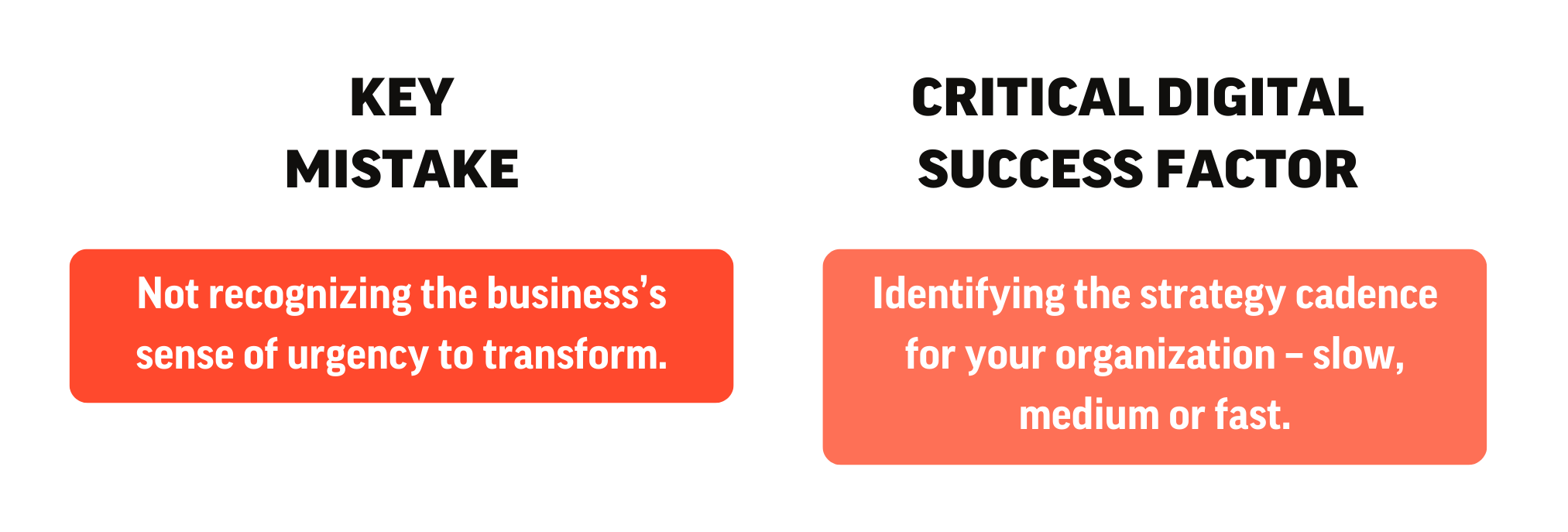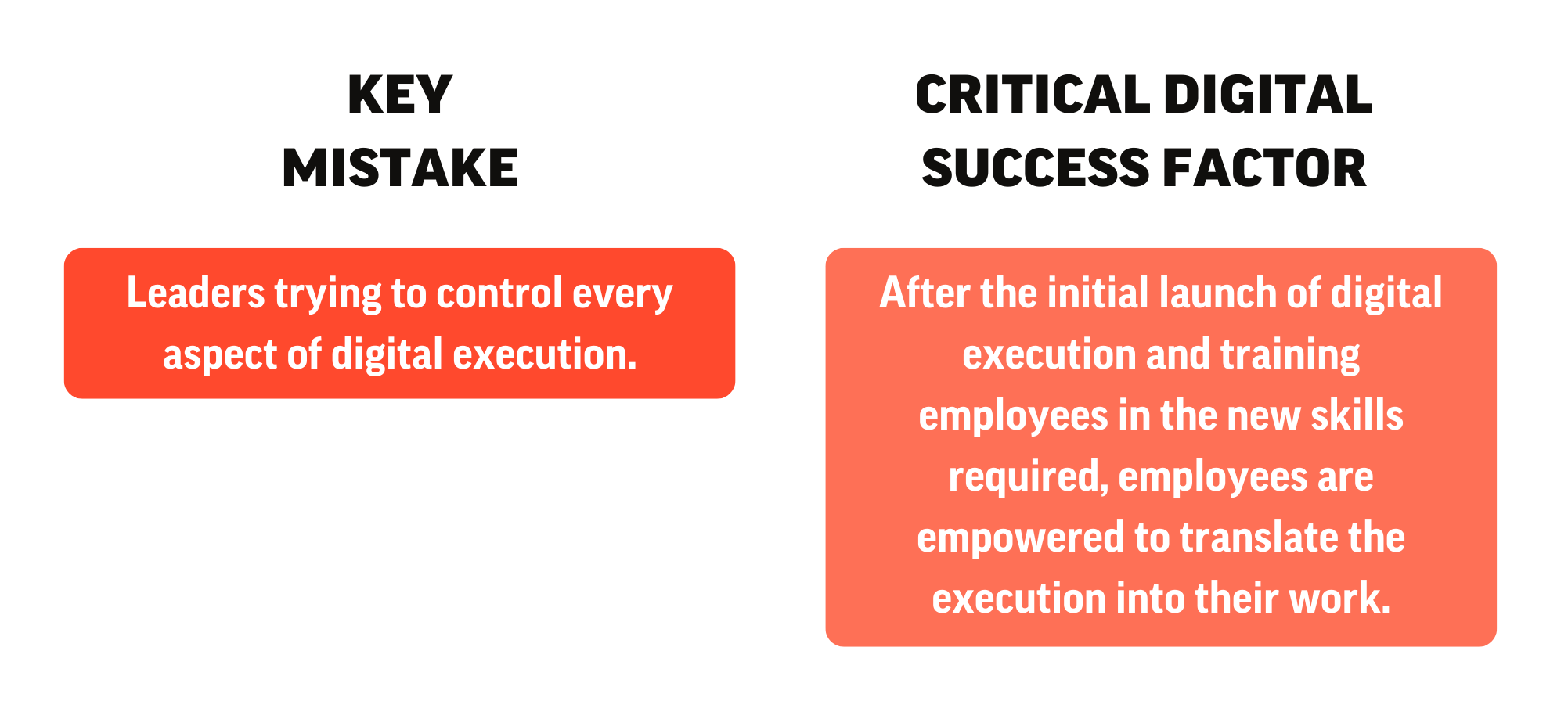How Digital Execution of Strategy Differs from Old Strategy Execution

For 19 years now, I have been presenting (and promoting) strategy execution from the stage and have been able to share with leaders our research that we have been steadily improving from nine out of ten strategy executions failing in 2000 to 67% failing in 2016. Until now.
According to Forbes magazine and IBM, 84% of companies are now failing at digital execution.
We are getting worse.
This is because execution of a digital strategy or in a digital world is even harder than previous executions.
As leaders around the world are recognizing the need to espouse digital, the critical question becomes “How do we successfully execute a strategy in a digital world?”.
Yesterday’s success no longer guarantees tomorrow’s results. Leaders are required to identify new strategies to remain competitive and change their modus operandi in a digital world. In digital execution, organizations cannot build on top of their current business model; they need a whole business model transformation to adopt digital.
Digital Execution is revolutionizing the way we conduct business
Just like the internet 18 years ago, except with a much bigger impact, organizations must:
- Respond faster than ever to customer requirements
- Be more customer- and operational-centric
- Develop agility by leveraging short experiments as part of their strategy
- Adopt the credo to fail early, fail fast and fail forward
- Leverage data analytics and data visualization for business optimization
- Identify ways to adopt and leverage artificial intelligence and to identify opportunities from the Internet of Things.
Understanding and acting on how digital execution differs from previous executions can make the difference between success and failure, due to seven key dissimilarities in the approach needed.
The DecideAct Strategy Execution Management Solution will be your strategy bestfriend in the digital world! All the Critical Success Factors below can be easily followed with right tool.
-
Whole Business Transformation Comes from the Core
Although some organizations initially adopt digital from the edges, eventually all must transform from the core. Previous executions don’t always require the business to transform from the core; it’s possible to adopt some strategies such as cost optimization or overseas growth that don’t need to change the fabric of the organization.
In digital execution, however, the critical difference is that it requires a whole business model shift that will, eventually, transform the business from the core. As digital is woven through every component of the business, it alters the DNA of the organization. This is because digital execution encapsulates various initiatives that have an effect across the organization’s value chain. The initiatives include artificial intelligence, big data, and human design thinking.
Some leadership teams question whether adopting a digital strategy should be from the core or the periphery. Adopting from the edges typically involves creating a separate team to do experiments, often from a remote location. They start producing small successes that eventually build traction to transform the whole organization. By comparison, other organizations that have failed tinkered with their business model but did not commit to a full-scale transformation.
There’s no right approach—a truth that can frustrate leaders. They need to determine what will work in their organization by considering the sense of urgency, culture, strategy, market, competition, and customer characteristics.
Key Mistake: Expecting digital execution to succeed while leveraging the organization’s current business model.
Critical Digital Success Factor: Digital execution affects every part of the business and requires a complete business model transformation.

- Culture – Back with a Bang
An organization’s culture has always been important in strategy implementation; today, it’s even more significant. With digital execution, almost all organizations require a culture change. This is because transformation of the whole business model translates to changing the fundamental way the organization operates. For almost all, this means changing the culture.
Failing to change the culture is among the top three reasons for the high failure rate. The culture must support digital execution. As the late Peter Drucker said, “Culture eats strategy for breakfast.” But in digital execution, this is not always true and, in fact, can be the other way around. With the accelerated pace of change in business today, strategy now eats culture. Allow me to elaborate.
The landscape has altered dramatically since Drucker made this famous statement. With businesses moving faster than at any time in history (and yet this is the slowest pace we will now ever work), the accelerated pace has dramatically reshaped the relationship strategy, culture, and execution.
In Drucker’s era, a strategy for an organization could typically span 10 years while assuming a decade of stability and growth. During that period, an organization strived for stability.
Today, most organizations are working at a faster strategy cadence (speed of execution) than ever. On average, that means the strategy has to change every three years. This fast pace of transformation translates to the organizational culture being in a constant state of flux to keep pace with the rapidly changing strategies.
Key Mistake: Assuming the culture that got you here will make you successful tomorrow.
Critical Digital Success Factor: Recognizing that culture drives the way an organization executes its strategy.

- Failure is a Necessity
With digital execution, your organization needs to fail before it can succeed. To transform the whole business, recognize that there will be failures. How leaders respond to them and to their employees can dictate the success of digital execution.
We know from behavioral psychology that negative reinforcement stops a behavior. That means that if employees try and fail and are then punished for their efforts, they will stop trying. Therefore, leaders must create a culture in which failure is acceptable and encouraged, but within certain parameters. This is because digital execution requires testing followed by new ways of working while adopting new approaches, tools and techniques.
When leaders say they want to create a “start-up” culture, that partly means having a structure that allows employees to try, fail, and learn. The parameters ensure that the organization learns from the failures and does not repeat them.
The mantra within many organizations today is “fail early, fail fast and fail forward.” For example, Google’s X – The Moonshot Factory was created in 2010 as a new division to work on: “Moonshots: sci-fi sounding technologies that aim to make the world a radically better place.” Inside the division, people are rewarded for stopping experiments that aren’t working. This frees up essential resources with time to focus on projects that might work. In Google’s office, employees are reminded by a sign on the wall that reads “Fail Well.”
Due to the rapid growth of FinTech, one industry that has to adopt digital to survive is banking. Prior to starting Bridges (my company) in 2000, I was a Regional VP in Citigroup. At that time, the bank’s culture was unforgiving—that is, anyone who makes a big mistake is out, no second chances. Fast forward to today, and banks now encourage failure. This requires a complete change in leadership thinking and how they manage the business.
Transformation needs to happen in both the leaders’ and the employees’ minds as well as the culture.
Key Mistake: Employees are punished for failing.
Critical Digital Success Factor: Leaders embrace failure as a stepping stone to success. They coach employees through decisions that don’t work so they can learn the right lessons and take the right actions.

- Digital Speedometer
It’s common for leaders to assume that they have to transform by tomorrow, and that all parts of the organization have to achieve digital execution at the same speed. Not so. The speed at which an organization executes its strategy is called its Strategy Cadence. While crafting the strategy, they decide the best Strategy Cadence, which has three gears of execution:
- Slow – more than five years
- Medium – less than five years and more than three years
- Fast – less than three years
Slow Strategy Cadence
If you intentionally select a Slow Strategy Cadence, it may be because the sense of urgency for digital execution is not urgent. Businesses in certain industries such as mining, agriculture, and aircraft manufacturers have up to 15 years to execute their strategies.
LVMH is adopting digital with Ian Rogers, previously from Apple, who is driving the transformation. LVMH has chosen a Slow Strategy Cadence because the barrier of entry to most of their markets is high. This allows them the luxury (excuse the pun) of time to transform. Having failed at their initial approach to digital in 2009 (called ELuxury.com), a different approach was required. Today, the leadership team has time to ensure the success of this digital execution, which goes across the 70 prestigious brands and a retail network of more than 4,370 stores worldwide.
Medium Strategy Cadence
Most organizations have a Medium Strategy Cadence. That means that every three to five years, they keep revisiting the need for change and crafting a new strategy.
During the Medium Strategy Cadence, leaders have only a few years to execute a new strategy. They are forced to drive the new strategy forward before products and/or services become obsolete and revenue streams vanish.
A higher number of organizations fall into the Medium Strategy Cadence pace than ever before because the strategic landscape is changing fast. This applies, for example, to construction and manufacturing. These industries have had to develop agility to adjust to the accelerated pace of change, so the sense of urgency is medium.
Fast Strategy Cadence
For some organizations, a five-year strategic plan—or even a three-year one—is a thing of the past. Because of disruption or losing market share, revenue and/or customers, they may be under pressure. It requires immediate corrective action, which carries a high risk without the luxury of time to study circumstances and involve a variety of people. These organizations have an extremely high sense of urgency and a need for speed.
Samsung is an example of an organization that executes fast, using a Fast Strategy Cadence to its advantage. For the last few years, its leaders have had a “fast market follower” strategy. That means they continually scan their industry for innovative new products that either threaten Samsung’s current business or offer new revenue opportunities. Then they design their own product for the market.
Consider the success Samsung has had with its Galaxy smartphone. This strategic approach became possible because of the speed and excellence at which Samsung’s culture enabled its people to work within the speed of change.
Samsung’s “fast market follower” strategy keeps changing as the organization strives to be first to market in certain product areas. This organization emphasizes the need for agility. As an example, in 2013, Samsung launched the Android-powered Galaxy Gear smartwatch. The following year, Apple’s iPhone 6 sales eradicated Galaxy Gear’s end-of-year profits. In response, Samsung is looking to develop wireless charging.
Key Mistake: Not recognizing the business’s sense of urgency to transform.
Critical Digital Success Factor: Identifying the strategy cadence for your organization – slow, medium or fast.

- Board Support
Because digital execution affects the whole organization, the Board needs to fully support the organization’s transformation. But before starting to transform, the Board and the leadership team must discuss and collaborate on key decisions, creating the digital vision for the organization. This includes changes to products and services offered to customers, potential changes in customer segments, and required changes in operations. It also includes allocating investments for adopting new technologies and expanding current ones as well as training employees and hiring external support, if required.
The leadership team and the Board must also agree on the roadmap for transformation and assign new metrics to track performance. To keep the Board’s support along the journey, Board members should be kept fully informed.
Key Mistake: Surprising your Board with digital execution initiatives.
Critical Digital Success Factor: Projecting the cost of digital execution and the returns as well as managing Board members’ expectations.

- Customer Centricity, for Real
For many years, leaders have adopted a strategy that involved being more customer-centric than ever. They trained their employees in customer service, adopted customer-centricity as a core value, and found ways to integrate the “voice of the customer” into the business. But many of the organizations failed to make the substantial changes required to sustain a permanent customer-centric culture.
A manufacturing organization, for example, focused on creating an omnipresence customer experience. The leaders enabled their sales team with digital tools so they could connect with their customers and respond faster to them. But they did not address how operations would deliver on the salespeople’s promises to customers. As a result, promises were made that the operations team could not fulfill, leading to customer dissatisfaction rather than satisfaction.
In digital execution, customer centricity is an essential component. It depends on an organization-wide understanding of customer problems that need to be solved as well as the different customer experience that can be created. Many leaders start their digital execution journey with customer centricity in the lead. They adopt techniques such as human-centered design so their employees can integrate digital solutions that create better customer experiences. It also results in significantly reduced costs, which can be passed on to customers. It can also potentially foster a flawless end-to-end customer experience. As McKinsey and Co reported, digitizing customer service can increase customer satisfaction by 33% and reduce costs by as much as 35%.
Key Mistake: Applying transformation predominantly to only one part of the organization as too many previous customer service initiatives have done.
Critical Digital Success Factor: Creating a customer-centric digital experience involves examining the process end-to-end and transforming it across the organization.

- Employee Empowerment, a Non-Negotiable
In previous executions, it was not always necessary to adopt empowerment. One of my clients in China, for example, was losing market share and revenue at an alarming rate. The new CEO dictated the changes that needed to happen, knowing the organization had to transform immediately to survive. Employees were told what to do—a necessary approach in this situation to plug the leaks and start to rebuild.
In digital execution, however, employee empowerment is non-negotiable. Why? Transforming the whole business cannot be done by dictating details from the top. Leaders need to point their employees in the right direction, set the parameters for empowerment and then step back, allowing them to take the right actions. And when they make mistakes, leaders must support them in learning from their experience.
DBS Bank in Singapore has not only been named the best digital bank in the world but also the best bank in the world (the first Asian bank to achieve either award). When Piyush Gupta, the CEO, initially started to transform the bank, he adopted situational leadership, meaning he attended all key meetings to ensure that what he wanted was being done. Now he goes to the meetings to find out what’s going on! The employees have been empowered to execute digital. Between the start and now, they were trained in what digital means. This included participating in hackathons and using the right tools for digital execution, including human design thinking and how to use big data.
Key Mistake: Leaders trying to control every aspect of digital execution.
Critical Digital Success Factor: After the initial launch of digital execution and training employees in the new skills required, employees are empowered to translate the execution into their work. As an organization achieves this, decision-making moves down the hierarchy.

Conclusion
Leaders are repeating the same mistakes from previous executions all over again in digital execution. To further complicate the situation, because digital execution is a larger transformation than previous executions, mistakes made by the organization are now magnified.
Both previous executions and digital execution require discipline and focus throughout the organization. The goal is to understand what’s required in the approach and drive the right actions that will lead the organization to success in this digital world.




.png?width=596&name=New%20Strategy%20Execution%20(1).png)



